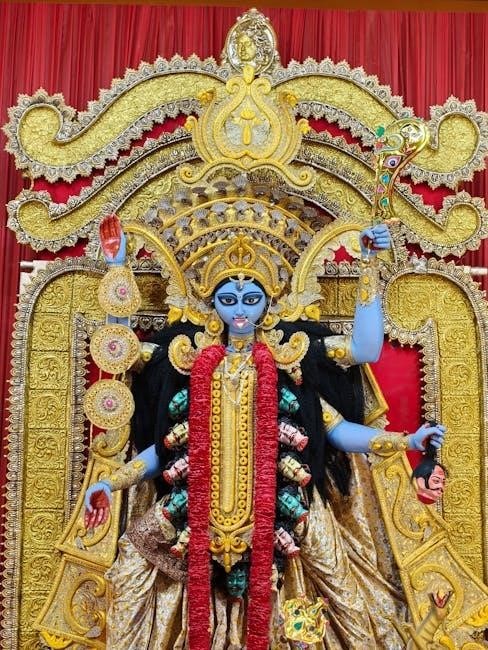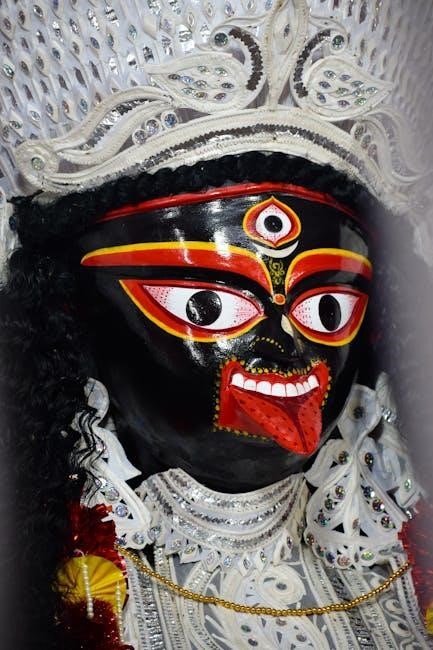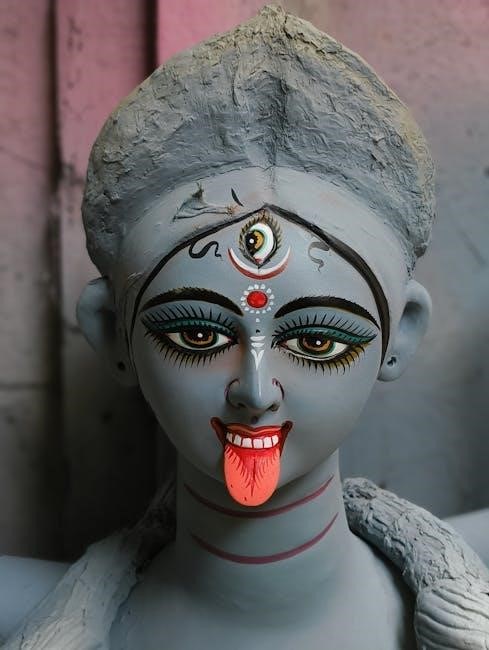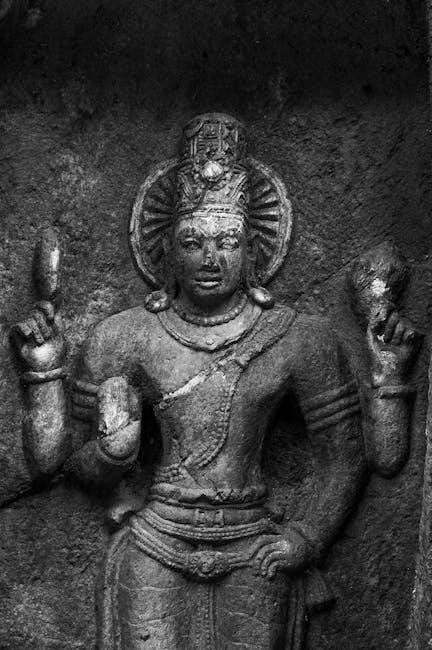mythology edith hamilton pdf
Summary
Explore ancient myths with Edith Hamilton’s timeless guide. Download the PDF now for a fascinating journey through mythology!

Edith Hamilton’s Mythology is a timeless classic that masterfully weaves Greek, Roman, and Norse myths into a captivating narrative․ First published in 1942, this iconic book has become a cornerstone of Western cultural studies, offering insights into the gods, heroes, and legends that shaped civilization․ Its lucid prose and rich storytelling continue to enchant readers, making it a foundational text for understanding ancient myths and their enduring influence on literature and art․

Structure and Organization of the Book
Edith Hamilton’s Mythology is meticulously organized, blending Greek, Roman, and Norse myths into a cohesive narrative․ The book is divided into clear sections, exploring gods, heroes, and legendary creatures, with a foreword and introduction that set the stage for its timeless stories․
Overview of the Book’s Layout
Edith Hamilton’s Mythology is structured into clear, thematic sections, making it easy for readers to navigate the vast array of myths․ The book begins with a foreword and introduction that contextualize the importance of mythology in understanding Western culture․ It is divided into three main parts: Greek, Roman, and Norse myths, each subsection detailing the gods, heroes, and legendary creatures․ The Greek section explores the Olympian gods, the creation of the world, and the stories of iconic heroes like Odysseus and Hercules․ The Roman section highlights the similarities and differences between Roman and Greek deities, while the Norse portion delves into the gods of Asgard and the end of the world, Ragnarök․ The book also includes a preface that discusses the diversity of mythological sources and the challenges of compiling them into a single volume․ The digital PDF version retains this structure, offering readers a seamless transition from print to digital format, with illustrations by Steele Savage enhancing the visual appeal of the narrative․
Sources and Inspirations

Edith Hamilton’s Mythology draws from a wide range of ancient sources, including Greek and Roman writers like Homer, Hesiod, Ovid, and Virgil․ These classical authors provided the foundation for the myths Hamilton presents, ensuring authenticity and depth․ Additionally, Norse myths are sourced from the Poetic Edda and Prose Edda, key texts of Norse literature․ Hamilton’s work is also influenced by her deep understanding of classical literature and her ability to synthesize complex narratives into accessible stories․ The digital PDF version of the book includes Steele Savage’s illustrations, which visually enhance the myths, making them more engaging for modern readers․ Hamilton’s approach to mythology is both scholarly and storytelling, blending historical accuracy with a narrative style that captivates readers; This blend of sources and inspirations results in a comprehensive and engaging exploration of Western mythology, making the book a valuable resource for both students and enthusiasts․
Key Themes and Elements in the Book
Edith Hamilton’s Mythology explores timeless themes like heroism, morality, and the human condition․ It delves into the cultural significance of myths, blending Greek, Roman, and Norse traditions․ The book highlights the universal lessons and enduring appeal of ancient stories, making them relatable to modern readers․
The Timeless Appeal of Mythology
Edith Hamilton’s Mythology captivates readers with its enduring themes, bridging ancient and modern worlds․ The book masterfully explores universal human experiences—heroism, love, and the struggle between good and evil—through timeless stories of gods, heroes, and mythical creatures․ By weaving together Greek, Roman, and Norse myths, Hamilton reveals their profound influence on Western culture, making them accessible and relatable to contemporary audiences․
The narratives, rich in moral and cultural lessons, resonate across generations, offering insights into human nature and societal values․ Hamilton’s lucid prose and organized presentation ensure that even complex myths are engaging and understandable․ This timeless appeal has made the book a staple in educational curricula, inspiring readers to explore the foundational stories of Western civilization․
Its ability to transcend time and connect with readers of all ages has solidified Mythology as a classic, ensuring its relevance in both academic and casual reading contexts․ The book’s enduring popularity highlights the power of myths to inspire and educate, making it a cherished resource for anyone interested in the cultural heritage of the West․

Moral and Cultural Lessons
Edith Hamilton’s Mythology is not only a collection of ancient stories but also a rich source of moral and cultural insights․ The book delves into the ethical dilemmas and societal values of ancient civilizations, offering timeless lessons that remain relevant today․ Through the tales of gods, heroes, and mythical creatures, Hamilton explores themes such as courage, justice, and the consequences of hubris, providing a moral framework that resonates with readers of all ages․
The myths of Greece, Rome, and Norse traditions are woven together to illustrate the cultural norms and beliefs of their respective societies․ Hamilton’s interpretation highlights the universal human experiences that underpin these stories, making them accessible and relatable․ For instance, the struggles of heroes like Odysseus and the moral ambiguities of gods like Zeus serve as reflections of human nature and societal expectations․
By examining these narratives, readers gain a deeper understanding of the cultural heritage that shapes Western civilization․ Hamilton’s work serves as a bridge between the past and present, offering moral guidance and cultural context that continue to inspire and educate․ This makes Mythology a valuable resource for both academic and personal exploration of ancient wisdom․
Greek Mythology in the Book
Edith Hamilton’s Mythology masterfully explores Greek myths, detailing the Olympian gods, Titans, and early heroes․ Her engaging narrative brings to life the creation stories and divine struggles that shaped ancient Greek culture, belief systems, and their enduring influence․

The Olympian Gods

Edith Hamilton’s Mythology vividly portrays the Olympian gods as central figures in Greek mythology, highlighting their distinct personalities and roles․ Zeus, the king of the gods, rules with authority, while Hera, his wife, embodies maternal power and jealousy․ Athena, the goddess of wisdom, and Apollo, the god of light and music, represent intellect and creativity․ Dionysus, the god of wine and ecstasy, contrasts with the more restrained deities, showcasing the diversity of their natures․ Hamilton’s narrative captures the intricate relationships and conflicts among the Olympians, such as Zeus’s affairs and the rivalries between gods․ These stories not only entertain but also reveal the moral and cultural values of ancient Greece․ By exploring the Olympian gods, Hamilton illustrates how their myths have shaped Western culture, influencing art, literature, and philosophy for centuries․ Her engaging prose makes these divine figures relatable and timeless, ensuring their enduring appeal to modern readers․
Heroes of Greek Mythology
Edith Hamilton’s Mythology brings to life the legendary heroes of Greek mythology, whose bravery and struggles have captivated readers for centuries․ Heroes like Hercules (Heracles), Theseus, and Perseus embody the human spirit’s capacity for courage and perseverance․ Their quests, often imposed by the gods, showcase the interplay between divine will and mortal determination․ Hercules’ twelve labors, for instance, highlight his immense strength and resilience, while Theseus’ slaying of the Minotaur in the Labyrinth exemplifies cleverness and valor․ Hamilton’s portrayal of these heroes not only recounts their adventures but also explores their vulnerabilities, making them relatable to modern readers․ The stories of Odysseus, with his decade-long journey home after the Trojan War, further illustrate the complexities of heroism, blending wit, endurance, and the human condition․ Through these narratives, Hamilton underscores the timeless appeal of Greek mythology, revealing how the heroes’ triumphs and tragedies continue to inspire and reflect universal human experiences․ Her vivid storytelling ensures that these legendary figures remain etched in the collective memory of Western culture․
Roman Mythology
Edith Hamilton’s Mythology explores Roman mythology, highlighting its unique blend of tradition and adaptation․ The Romans drew heavily from Greek myths but infused them with their own cultural values, emphasizing civic duty and patriotism․ Their pantheon, featuring gods like Jupiter and Mars, reflects a focus on law, order, and the state, distinguishing it from Greek mythology’s emphasis on individual heroism․ Hamilton’s work illuminates how Roman myths, though often less dramatic than their Greek counterparts, played a vital role in shaping Roman identity and society․ Her narrative bridges the gap between Greek and Roman traditions, showcasing the evolution of mythological themes in the ancient world․ This section of her book offers a compelling insight into the Roman worldview and its enduring legacy in Western culture․
Roman Gods and Their Greek Counterparts
In Edith Hamilton’s Mythology, the Roman pantheon is explored in depth, revealing its close ties to Greek mythology․ Roman gods were often direct counterparts to Greek deities, with similar roles and stories but adapted to Roman culture․ For instance, Jupiter, the king of the Roman gods, mirrors Zeus, while Mars, the god of war, aligns with Ares․ Venus, the Roman goddess of love, corresponds to Aphrodite, and Mercury, the messenger god, is akin to Hermes․ These parallels highlight the Romans’ practice of adopting and reinterpreting Greek myths to align with their own values and traditions․
Hamilton’s work emphasizes how Roman mythology, while derivative, infused these stories with a unique focus on civic duty, law, and patriotism․ The Romans often stripped myths of their dramatic complexity, focusing instead on moral lessons and the glorification of the state․ This adaptation process reflects the Roman emphasis on practicality and communal identity, distinguishing their mythological narratives from the more individualistic Greek traditions․ By examining these counterparts, Hamilton illustrates the cultural and philosophical differences between the two civilizations, offering readers a nuanced understanding of how mythology evolved in the ancient world․
Norse Mythology
Edith Hamilton’s Mythology delves into the captivating world of Norse myths, introducing readers to gods like Odin, Thor, and Loki․ The book vividly portrays the cosmic events of Ragnarok and the intricate tales of Valhalla, offering a rich exploration of Northern Europe’s mythological heritage․
The Gods of Asgard
Edith Hamilton’s Mythology vividly portrays the gods of Asgard, central to Norse mythology․ Odin, the All-Father, is depicted as a wise and mysterious leader, while Thor, with his mighty hammer Mjolnir, embodies strength and protection․ Loki, the trickster, is shown as a complex figure, oscillating between mischief and malice․ The gods’ realm, Asgard, is described as a place of grandeur, connected to Earth by the rainbow bridge Bifrost․ Hamilton highlights the unique fatalism of Norse mythology, where even the gods are destined to fall in the apocalyptic event of Ragnarok․ Unlike Greek deities, the Norse gods are often portrayed as more human-like, grappling with mortality and the inevitability of their doom․ Their stories, as presented by Hamilton, reveal a deep connection to nature and the cosmos, offering readers a rich tapestry of Northern Europe’s mythological heritage․ The gods of Asgard, through Hamilton’s lens, remain timeless figures, inspiring awe and reflection on the human condition․

Heroes and Legendary Creatures
Edith Hamilton’s Mythology brings to life legendary heroes like Odysseus and Hercules, and mythical creatures such as dragons and Cyclops․ These figures embody courage, cunning, and the supernatural, enriching the tapestry of ancient myths with their extraordinary tales and struggles․
The Great Heroes
In Edith Hamilton’s Mythology, the great heroes of ancient myths are portrayed as embodiments of courage, wit, and determination․ Figures like Odysseus, Jason, Hercules, and Perseus captivate readers with their epic quests and battles against formidable foes․ Their stories, deeply rooted in human emotion and struggle, highlight the universal themes of perseverance and the pursuit of glory․
Odysseus, the cunning king of Ithaca, exemplifies intelligence and resilience as he navigates the challenges of his decade-long journey home․ Hercules, with his twelve labors, represents the triumph of strength and virtue over monstrous forces․ Jason and the Argonauts’ quest for the Golden Fleece showcases teamwork and sacrifice, while Perseus’s battle with Medusa demonstrates bravery and cleverness․
These heroes, though flawed, inspire admiration and reflection․ Their tales, as retold by Hamilton, not only entertain but also offer moral lessons and insights into the human condition․ The great heroes of mythology remain timeless figures, continuing to influence art, literature, and culture to this day․

The Digital Version: “Mythology” in PDF Format
The digital version of Edith Hamilton’s Mythology is widely available in PDF format, offering convenient access to its timeless tales․ Readers can download it from platforms like Scribd or PDFDrive, ensuring the classic remains accessible for modern audiences․
Availability and Access
Edith Hamilton’s Mythology in PDF format is widely accessible, ensuring its timeless tales reach a broad audience․ The digital version is available on platforms like Scribd, PDFDrive, and Internet Archive, offering easy downloads for readers worldwide․ Many websites provide free access to the PDF, making it a convenient option for students and enthusiasts alike․ The 75th anniversary edition, featuring stunning illustrations, is also available in digital form, enhancing the reading experience․ Additionally, authorized reprints from publishers like Little, Brown and Company ensure the PDF’s quality and authenticity․ This digital accessibility has made Mythology a popular choice for educational purposes, with many high schools and universities recommending it as a key resource for studying Western mythology․ The PDF format allows for searchable text and adjustable font sizes, improving readability․ Overall, the digital version of Mythology remains a vital and accessible resource for exploring the rich tapestry of Greek, Roman, and Norse myths․

Study Guides and Summaries
For readers seeking a deeper understanding of Mythology by Edith Hamilton, numerous study guides and summaries are available to complement the book․ These resources provide detailed analyses of the myths, characters, and themes, making them invaluable for students and casual readers alike․ Many websites offer free PDF downloads of study guides, which include chapter-by-chapter breakdowns, character profiles, and historical context․ Platforms like Scribd and PDFDrive host comprehensive summaries that highlight key events and moral lessons from the myths․ Additionally, lesson plans and Q&A sections are available, catering to educators and students who use the book in academic settings․ These study aids are particularly useful for grasping the complexities of Greek, Roman, and Norse mythology, as well as Hamilton’s interpretative approach․ The availability of these resources ensures that readers can engage with the book on a deeper level, enhancing their appreciation of its timeless stories and cultural significance․
Reception and Reviews
Edith Hamilton’s Mythology has received widespread acclaim for its masterful retelling of ancient myths․ Readers and scholars alike praise its ability to make complex stories accessible and engaging․ The book is often described as a foundational text for understanding Western cultural heritage, with many considering it a must-read for both students and casual enthusiasts․ Its clear and concise narrative style has made it a favorite in educational settings, with many high schools adopting it as a core text for mythology courses․ The inclusion of Steele Savage’s illustrations in some editions further enhances the reading experience, adding a visual dimension to the timeless tales․ Reviewers highlight the book’s ability to balance depth and readability, making it a valuable resource for anyone exploring Greek, Roman, and Norse mythology․ The 75th anniversary edition, in particular, has been celebrated for its stunning design and enduring appeal․ Overall, Mythology remains a beloved classic, earning high praise for its insightful and captivating portrayal of ancient myths․
Edith Hamilton’s Mythology stands as a monumental work that has bridged the gap between ancient myths and modern readers․ Its ability to weave Greek, Roman, and Norse myths into a cohesive narrative has made it a cornerstone of Western cultural education․ The book’s clear, engaging style has ensured its relevance across generations, earning it a place in classrooms and personal libraries alike․ By distilling complex stories into accessible prose, Hamilton has preserved the essence of these timeless tales, allowing readers to connect with the heroes, gods, and legends that shaped human history․ The availability of the book in PDF format has further expanded its reach, making it accessible to a global audience․ As a result, Mythology remains not only a scholarly resource but also a source of inspiration, reminding us of the enduring power of myth to illuminate the human condition․ Its legacy as a classic work of cultural and literary significance continues to grow, ensuring that the stories of old remain alive and vibrant for future generations․
